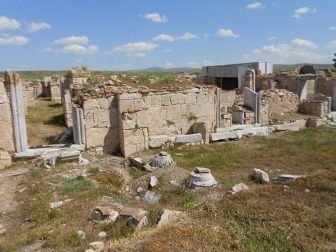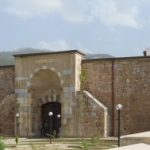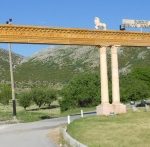The “Emir’s Mountain” Population: 19,000
Market day: Tuesday
If you want to visit the ruins of Amorium northeast of Afyon, you will need to transit Emirdağ, a small town with nothing to detain a tourist (the only building of any distinction that I could find was the Ortaokul or Middle School).
Amorium is 12km out of town to the east in the hamlet of Hisar (Castle) which lies just beyond a village called Suvermez (It Doesn’t Give Water).
Overlooked by Mt Emirdede, Hisar, while quaint, is effectively dead and it’s a great shame to arrive and find the ruins completely fenced off and with no explanatory signs. The caretaker who appeared as soon as I did was unable to let me into the site – apparently permission must be obtained in advance from the museum in Afyon. Predictably, there are almost no visitors.
Backstory
Hard though it is to believe it now, in A Byzantine Journey John Ash states that Amorium was by the early years of the eighth century “the greatest city in Anatolia” with a population of at least 35,000.
The iconoclast emperor Theophilus (r.829-842) was born here and the Amorian dynasty that he founded took its name from his birthplace.
In 838 the Arab Caliph al-Mu’tasim besieged the city, almost certainly in revenge for Theophilus’ own attack on Sozopetra. After holding out for 55 days the garrison was finally betrayed. Thirty thousand people are said to have been killed, and Amorium was burnt to the ground, a disaster Ash described as “a singularly futile act of inhumanity.”
The caliph was unable to capitalise on his victory and this was the last time the Arab raiders posed a serious threat to the survival of the Byzantine Empire.
Amorium was rebuilt only to be sacked again by the Turks in the 11th century. By the 14th century it had fallen from the pages of history altogether.
Around the site
Within the main enclosed area low metal roofs cover what are apparently the ruins of a hamam and a şaraphane (winery). In a separate area the remains of what must have been a sizeable church, the doors from its narthex into the body of the church lined with locally-mined marble, are a little easier to see across the fence.
It’s obvious that remains lie underground in the surrounding fields waiting for someone to excavate them. 
Transport info
Local minibuses leave the Köy Garaj in Afyon for Emirdağ more frequently than the larger buses from the main otogar (services from the otogar virtually dry up on a Sunday). Return minibuses leave from an office opposite the Buzlu bus ticket office near the main square with its modern clocktower.
In Emirdağ the taxi drivers know the road to Hisar although not necessarily where to find the ruins.


